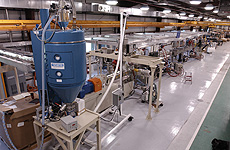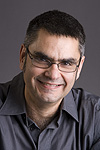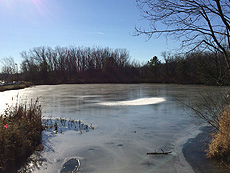Have a safe day!
Wednesday, Nov. 26
3:30 p.m.
Director's Coffee Break - WH2XO
THERE WILL BE NO FERMILAB COLLOQUIUM THIS WEEK
Thursday, Nov. 27 and Friday, Nov. 28
Happy Thanksgiving!
Monday, Dec. 1
THERE WILL BE NO PARTICLE ASTROPHYSICS SEMINAR THIS WEEK
3:30 p.m.
Director's Coffee Break - WH2XO
4 p.m.
All Experimenters' Meeting - Curia II
Visit the labwide calendar to view Fermilab events
|
|
Wednesday, Nov. 26
- Breakfast: sausage gravy omelet
- Breakfast: ham, egg and cheese English muffin
- Barbecue beef brisket sandwich
- Chicken vesuvio
- Herbed pot roast
- Turkey bacon panino
- Greek chicken salad
- Chunky broccoli cheese soup
- Texas-style chili
- Assorted calzones
Wilson Hall Cafe menu |
|
Wednesday, Nov. 26
Lunch
- Cheese fondue
- Mixed green salad
- Strawberry almond tart
Friday, Nov. 28
Dinner
Closed
Chez Leon menu
Call x3524 to make your reservation.
|
|
Scintillator extruded at Fermilab detects particles around the globe
 |
| The plastic scintillator extrusion line, shown here, produces detector material for export to experiments around the world. Photo: Reidar Hahn |
Small, clear pellets of polystyrene can do a lot. They can help measure cosmic muons at the Pierre Auger Observatory, search for CP violation at KEK in Japan or observe neutrino oscillation at Fermilab. But in order to do any of these they have to go through Lab 5, located in the Fermilab Village, where the Scintillation Detector Development Group, in collaboration with the Northern Illinois Center for Accelerator and Detector Design (NICADD), manufactures the exclusive source of extruded plastic scintillator.
Like vinyl siding on a house, long thin blocks of plastic scintillator cover the surfaces of certain particle detectors. The plastic absorbs energy from collisions and releases it as measurable flashes of light. Fermilab’s Alan Bross and Anna Pla-Dalmau first partnered with local vendors to develop the concept and produce cost-effective scintillator material for the MINOS neutrino oscillation experiment. Later, with NIU’s Gerald Blazey, they built the in-house facility that has now exported high-quality extruded scintillator to experiments worldwide.
“It was clear that extruded scintillator would have a big impact on large neutrino detectors,” Bross said, “but its widespread application was not foreseen.”
Industrially manufactured polystyrene scintillators can be costly — requiring a labor-intensive process of casting purified materials individually in molds that have to be cleaned constantly. Producing the number of pieces needed for large-scale projects such as MINOS through casting would have been prohibitively expensive.
Extrusion, in contrast, presses melted plastic pellets through a die to create a continuous noodle of scintillator (typically about four centimeters wide by two centimeters tall) at a much lower cost. The first step in the production line mixes into the melted plastic two additives that enhance polystyrene’s natural scintillating property. As the material reaches the die, it receives a white, highly reflective coating that holds in scintillation light. Two cold water tanks respectively bathe and shower the scintillator strip before it is cool enough to handle. A puller controls its speed, and a robotic saw finally cuts it to length. The final product contains either a groove or a hole meant for a wavelength-shifting fiber that captures the scintillation light and sends the signal to electronics in the most useful form possible.
Bross had been working on various aspects of the scintillator cost problem since 1989, and he and Pla-Dalmau successfully extruded experiment-quality plastic scintillator with their vendors just in time to make MINOS a reality. In 2003, NICADD purchased and located at Lab 5 many of the machines needed to form an in-house production line.
“The investment made by Blazey and NICADD opened extruded scintillators to numerous experiments,” Pla-Dalmau said. “Without this contribution from NIU, who knows if this equipment would have ever been available to Fermilab and the rest of the physics community?”
Blazey agreed that collaboration was an important part of the plastic scintillator development.
“Together the two institutions had the capacity to build the resources necessary to develop state-of-the-art scintillator detector elements for numerous experiments inside and outside high-energy physics,” Blazey said. “The two institutions remain strong collaborators.”
Between their other responsibilities at Fermilab, the SDD group continues to study ways to make their scintillator more efficient. One task ahead, according to Bross, is to work modern, glass wavelength-shifting fibers into their final product.
“Incorporation of the fibers into the extrusions has always been a tedious part of the process,” he said. “We would like to change that.”
—Troy Rummler
|
Rush Holt, physicist and congressman, to lead AAAS
From Science, Nov. 18, 2014
Rush Holt, a physicist, educator, and eight-term Democratic member of Congress, has been named the new CEO of AAAS (which publishes ScienceInsider). He will succeed Alan Leshner, a neuroscientist who is stepping down this winter after leading AAAS since 2001.
Holt, 66, has represented a New Jersey district since 1999, but in February announced he would not seek another term. Although not known for sponsoring legislation, Holt has earned kudos from both Republican and Democrat colleagues for being an effective, behind-the-scenes advocate for additional funding for research and science education. He was part of an unofficial, bipartisan "physics caucus" in Congress that, at its peak, totaled three members who held physics Ph.D.s.
Read more
|
Galaxies in filaments spaced like pearls on a necklace
From New Scientist, Nov. 21, 2014
Galaxies like to keep their distance — 30 million light years of it, to be precise. An analysis of thousands of galaxies finds that they are strung like pearls on a necklace, even on relatively small scales.
On large scales, the universe is comprised of empty voids, punctuated by narrow, winding filaments of dark matter that guide the growth of galaxies and galaxy clusters. This cosmic web, which has taken decades to map, holds a repeating pattern on the order of hundreds of millions of light years.
But when you zoom in, things were supposed to get messier. Now, Elmo Tempel and his student Maarja Bussov at Tartu Observatory in Estonia and their colleagues have found a small-scale pattern in cosmic structure.
Read more
|
|
Strengthening the computing foundation of Fermilab
 |
|
Panagiotis Spentzouris |
Panagiotis Spentzouris, head of the Scientific Computing Division, wrote this column.
Scientific computing, through the process of numerical modeling and simulation, complements theory and experiment as a way to obtain scientific knowledge. But computing is more than the third leg of the discovery stool. Scientific computing also supports and enables the other two through data collection, reconstruction and analytics. It has always been an essential part of the Fermilab physics program.
Every time I see a picture of an event from the Large Hadron Collider's CMS experiment or, in more recent times, a NOvA event, I think of our Scientific Computing Division's contributions. NOvA hit the ground running, collecting data with an SCD-designed and -commissioned data acquisition system, processing data with SCD-developed software, and running on computing resources supported by SCD workflow management services and operations. SCD also develops and supports tools and applications for detector and accelerator simulation and physics generation.
All in all, SCD has been exceedingly successful in delivering world-class computing services, operations and software engineering support to Fermilab-based experiments, CMS and the high-energy physics community at large, working closely with our users. However, as Fermilab moves forward with the P5 plan, we face many scientific computing challenges.
First, we must provide the same high level of support to various experiments with different timelines and priorities. In addition, as computing architectures evolve, we must change the paradigms for how we construct our algorithms, write our codes and organize our analysis flows. Also, while new technologies, such as more accessible cloud computing, provide attractive possibilities for deploying computing resources, they require us to develop new services for on-demand reliable resource allocation.
In order to meet these challenges and continue to serve the needs of our user community, we have reorganized SCD and aligned our activities across three major areas. One is development, integration and research, in which we create the products that run on our facilities. The second is facilities, where we operate the services that run these products. The third is science operations and workflows, through which we tailor applications of the facility services to our experiments and projects and assist with operations.
Of course, no organization can be successful without its people. In the nearly three months since I became division head, my interactions with all parts of SCD have reinforced this belief. SCD members have unique and diverse skills in a variety of professions, including scientists, engineers, software architects and developers, and experts in using and operating high-performance and high-throughput computing systems.
It is very exciting to be at Fermilab now. The Fermilab neutrino program is on its way with more experiments to come online; CMS is about to restart taking data; the muon program will start soon; and our accelerator complex upgrades are well under way. We in SCD are looking forward to working with the rest of the laboratory to make this program a great success. Happy Thanksgiving!
|
Beginning of winter
 |
| Sun reflects off the glassy surface of a frozen Kidney Pond. Photo: Kris Brandt, CCD |
|
Wilson Hall closed Nov. 28-29 for maintenance
Wilson Hall will be closed for maintenance on Friday, Nov. 28, and Saturday, Nov. 29, and power to the building will be shut off. Please turn off all electronics before leaving today for the holiday.
The Fermilab site will still be open to the public from 8 a.m. to 8 p.m., but Wilson Hall will be locked.
|
ESH&Q weekly report, Nov. 25
This week's safety report, compiled by the Fermilab ESH&Q Section, contains three incidents.
An employee sprained his shoulder while lifting heavy objects. He returned to work with limitations on the use of his left arm.
An employee lacerated his ear while emerging from above a ceiling. He received medical treatment.
A variable-frequency drive for a fan blew apart, also blowing off the panel door, which hit an employee in the torso. He received medical attention and was released with no restrictions.
See the full report.
|
|